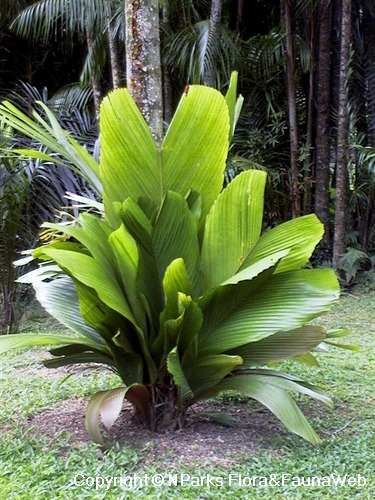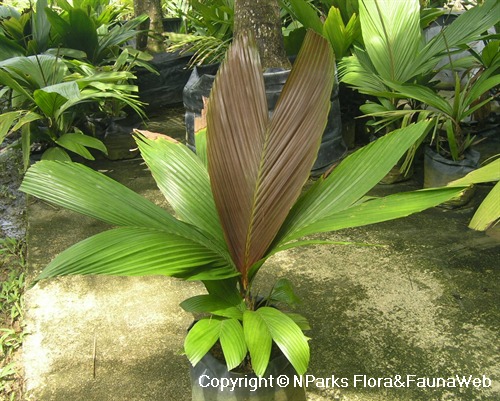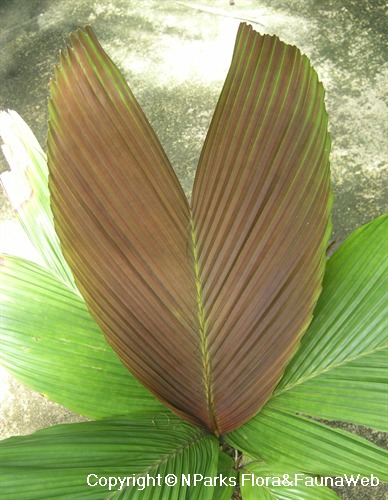_lowres.jpg)
Back
Iguanura wallichiana (Mart.) Benth. & Hook.f. ex Becc.
| Family Name: | Arecaceae (Palmae) |
| Synonyms: | Areca wallichiana Mart. |
| Common Name: | Pinang Hutan, 瓦氏鬣蜥棕 |
Name
Classifications and Characteristics
| Plant Division | Angiosperms (Flowering Seed Plants) (Monocotyledon) |
|---|---|
| Plant Growth Form | Palm |
| Lifespan (in Singapore) | Perennial |
| Mode of Nutrition | Autotrophic |
| Maximum Height | 3 m |
| Maximum Plant Spread / Crown Width | 3 m |
Biogeography
| Native Distribution | Thailand and Malaysia |
|---|---|
| Native Habitat | Terrestrial |
| Preferred Climate Zone | Tropical |
| Local Conservation Status | Non-native |
Description and Ethnobotany
| Growth Form | A small, clumping understorey palm with attractive, bright green, variable fronds that are either entire or divided with coarse or fine leaflets. |
|---|---|
| Foliage | There are 6 - 10 fronds per stem. They are bright green, ascending to spreading, with tips splitting like a fishtail. Sheaths are tubular and can reach up to 25 cm long. They are persistent but disintegrating. Petiole can reach up to 15 cm long. Young leaves emerge reddish and gradually turn green as they matures. |
| Flowers | Inflorescence occur between the fronds (interfoliar), in clusters of 1 - 3 per stem. They can reach up to 75 cm long and are sometimes branching. |
| Fruit | Fruit is long-ovoid, about 1.8 - 3 cm long and 1.5 - 2 cm wide. It turns pinkish to red when ripe and contains one seed within. |
| Habitat | It is found in rainforests, up to 800 m altitude, and sometimes in limestone forests. |
| Cultivation | It prefers partial shade, will also grow well in full shade. It likes constant moisture and well-draining soils that are rich in organic matter. This palm responds well to mulching and regular watering. Single plants are capable of producing fertile seeds but it is reported that seeds are not often viable. It can be propagated by division and seeds, which germinate in about 2 to 4 months with bottom heat. |
| Etymology | The genus epithet derives after a reptile with a tail, in reference to its inflorescence of this palm. The species epithet honours Nathaniel Wallich, 19th century Danish botanist and surgeon who had described many new species of plant and made a large herbarium collection. |
Landscaping Features
| Desirable Plant Features | Ornamental Foliage |
|---|---|
| Landscape Uses | General |
Fauna, Pollination and Dispersal
| Pollination Method(s) | Biotic (Fauna) |
|---|
Plant Care and Propagation
| Light Preference | Semi-Shade, Full Shade |
|---|---|
| Water Preference | Moderate Water |
| Plant Growth Rate | Moderate |
Foliar
| Mature Foliage Colour(s) | Green |
|---|---|
| Prominent Young Flush Colour(s) | Red |
| Leaf Area Index (LAI) for Green Plot Ratio | 2.5 (Palm - Solitary) |
Non - Foliar and Storage
| Trunk Type (Palm) | Aboveground, Clustering Habit |
|---|
Floral (Angiosperm)
| Flower Colour(s) | Cream / Off-White |
|---|
Fruit, Seed and Spore
| Mature Fruit Colour(s) | Red |
|---|
Image Repository
Others
| Master ID | 1339 |
|---|---|
| Species ID | 2632 |
| Flora Disclaimer | The information in this website has been compiled from reliable sources, such as reference works on medicinal plants. It is not a substitute for medical advice or treatment and NParks does not purport to provide any medical advice. Readers should always consult his/her physician before using or consuming a plant for medicinal purposes. |

_lowres.jpg)
_lowres.jpg)
_lowres.jpg)


